https://gds.blog.gov.uk/story-2013/
A GDS Story 2013
This is one part of “A GDS story”. Please read the introduction and the blog post that explains this project.
More of the story: 2010, 2011, 2012, 2014, 2015, 2016, 2017, 2018, 2019, 2020, 2021
6 January
Mike Bracken wrote a brief timeline of delivery to date.
13 January
Transactions Explorer tool was updated to include “data on the cost per transaction for 44 of the biggest services the Government offers its citizens”. Then-Minister for the Cabinet Office, Francis Maude, wrote:
Making this data public is a big step forward for transparency. The UK Government has never done anything like this before.
15 February

20 January
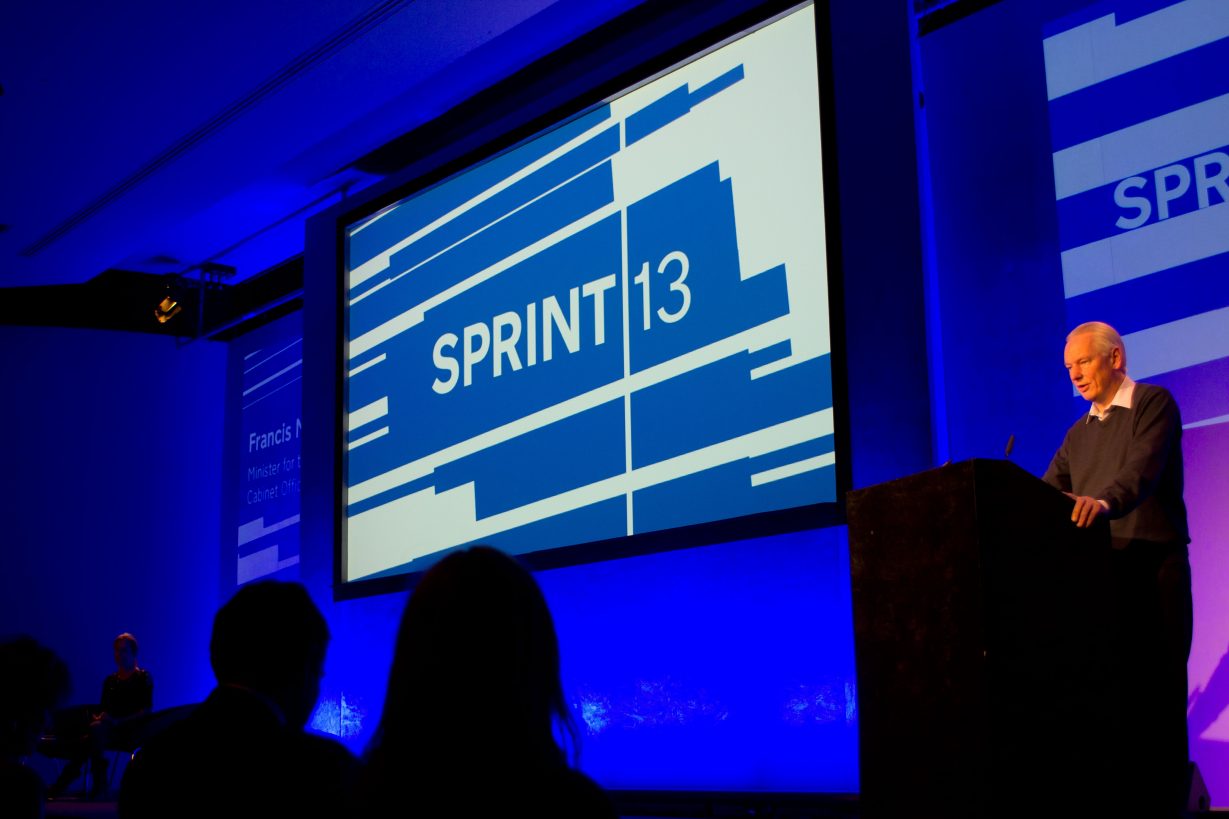
GDS hosted Sprint 13 in London – the first in a series of annual events focusing on digital transformation work across government. Francis Maude announced the Transformation Programme, a 2-year project to update 25 of the largest transactional services in government (subsequently known as the exemplar projects).
Photos were published the following day. Stephen Kelly (then-Chief Operating Officer for government) blogged soon afterwards, announcing "400 days to transform government". (More photos.)
31 January
Roger Oldham from the Ministry of Justice used the GDS blog as a recruitment channel, to hire new people for the team that would later become MoJ Digital. This was a positive step forward; it showed other departments making use of the same model established by Cabinet Office.
22 February
Abby Peel blogged about welcoming international visitors to GDS.
28 February

Neil Williams blogged about changes to Inside Government since it went into initial beta a year before:
What we are building is not only world class, but a world first. The governments of New Zealand, Croatia, Sweden and Norway have told us they intend to reuse aspects of what we have built, from the design down to the entire codebase.
1 March
HMRC corporate content moved to GOV.UK. Robin Riley from HMRC wrote:
I would argue that HMRC has had the longest journey of any Department to arrive at this point so far. Why? Because, bluntly, we started from furthest behind. Take a look at the new home for HMRC corporate information, and then take a look back at the old home (pictured above, now archived). The difference is dramatic. And much more than cosmetic. HMRC has re-engineered the way it publishes corporate information online.
12 March
“We’re not 'appy”: Tom Loosemore told government to stop making apps:
Apps may be transforming gaming and social media, but for utility public services, the ‘making your website adapt really effectively to a range of devices’ approach is currently the better strategy. It allows you to iterate your services much more quickly, minimises any market impact and is far cheaper to support.
14 March
Work lead by Liam Maxwell as CTO surfaced today, when Mike Bracken announced sweeping changes to IT governance across government:
We need fewer meetings between large budget holders to discuss procurement, and more stand-up meetings and daily releases based on user need. Or in short, we can do much more, more quickly by using the web, and digital tools and services internally, to collaborate.
In short, Maxwell and his team had replaced the old government IT governance structure, which looked like this:
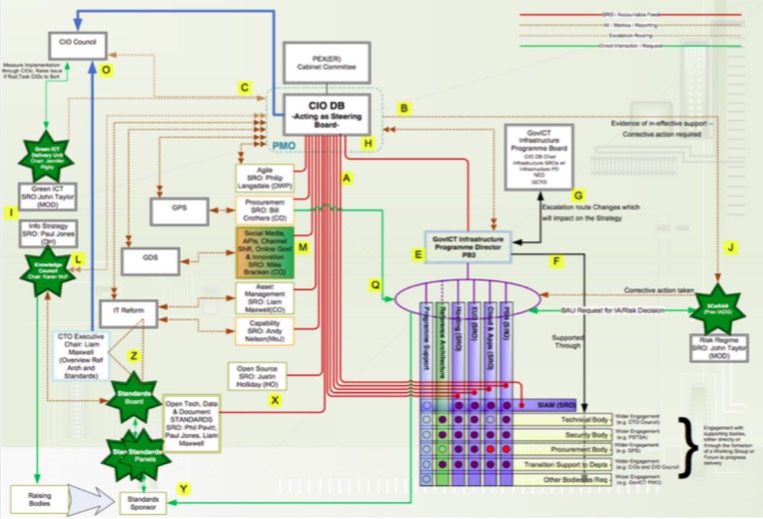
… with something that worked like this:
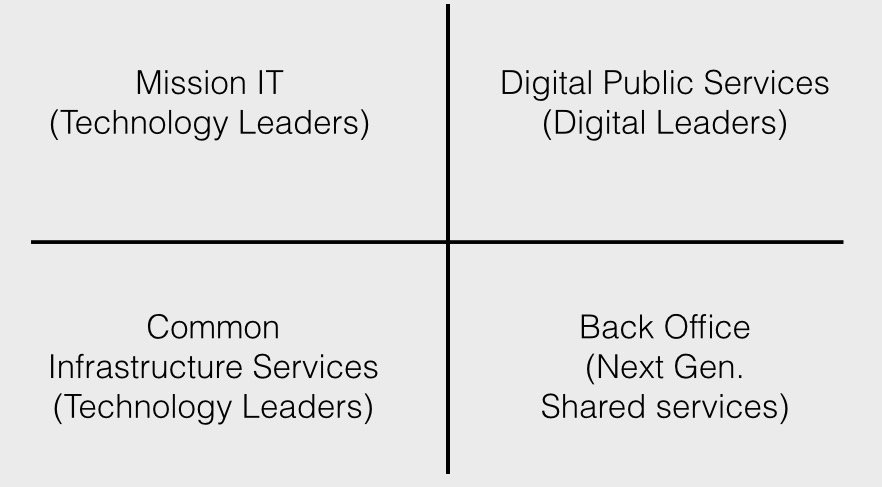
On the same day, GDS published the Digital by Default Service Standard and the Service Manual in beta.

These were how-to guides for civil servants, telling them everything they needed to know to build digital services in the right way:
The standard will be applied to all large services from April 2014. The point of the standard is to make sure that every service that’s published on GOV.UK is so straightforward and convenient that all those who can use them will choose to do so, and that appropriate assisted digital measures have been put in place for those who are offline.
We made a series of films to accompany the new manual.
20 March
Francis Maude, speaking in House of Commons:
I agree with everything that the hon. Gentleman says except his assumption that we are not already doing this. I know he is a member of the Design Commission, which produced that excellent publication; it is in fact very complimentary about a number of initiatives that the Government have taken, including the creation of the Government Digital Service, which is committed to ensuring that as we reform the delivery of public services, they are designed around the needs of the user rather than, as has far too often been the case, designed to suit the convenience of the Government.
(Watch a video clip of this speech.)
21 March
Richard Pope wrote about the process behind creating the Manual:
At the outset, it wasn't clear that we were making a manual. Our brief was to draw up the thing that all new services will be judged against – the Digital by Default Service Standard, as set out in the government's digital strategy. We knew that it needed to offer the rich detail to help departmental service owners and their teams deliver great digital services, while providing a simple, shared definition of what a good government digital service looks like.
25 March
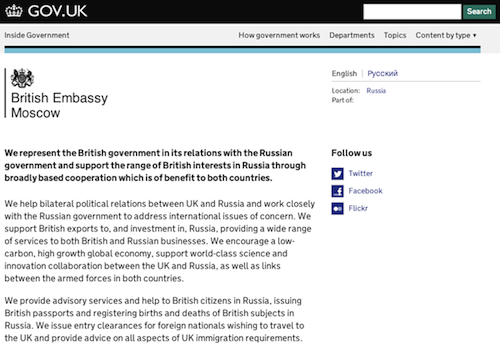
A new Worldwide section was added to Inside Government, with support for 44 languages. This was a big transition moment for departments like FCO, DFID, UKTI and MOD.
26 March
The first public signs of the work that would later become the Common Technology Services team, here in a blog post by Tariq Rashid from the IT Reform Group.
28 March
Departments were encouraged to start making use of the new HTML publication format on GOV.UK, designed to be a “digital by default replacement for PDF/RTF/Word file attachments”.
16 April
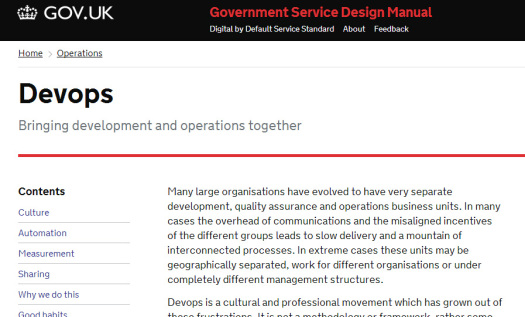
The Service Manual moved from beta to live.
Mike Bracken wrote:
...this manual is designed to free up government from the dead hand of bureaucratic overkill. This browser-based service will accelerate decision making and remove the need for many boards and unwieldy processes. As our digital services become primarily digital, the tools and governance we use should reflect that.
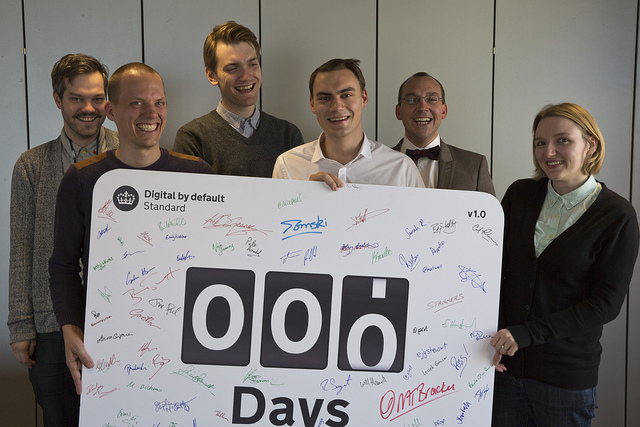
17 April
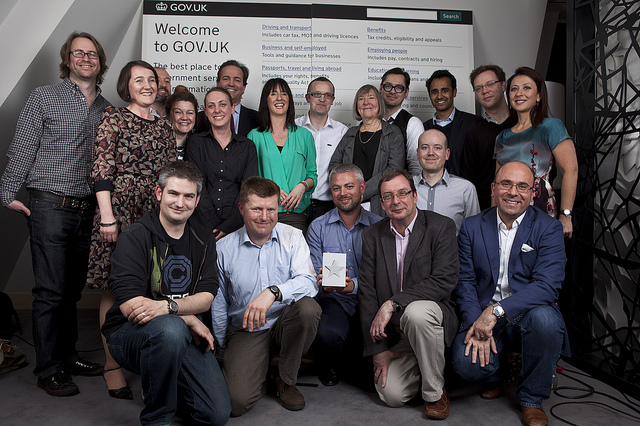
GOV.UK won Design of the Year for "well thought-out, yet understated design".
Writing in the Daily Telegraph, critic Deyan Sudjic said:
It’s a reflection of the government understanding how to communicate with the country in a way that works, it’s simple, direct, well mannered, all the things that we would like to take for granted from the government, but in a sea of red tape and jargon, usually can’t. Gov.uk looks elegant, and subtly British thanks to a revised version of a classic typeface, designed by Margaret Calvert back in the 1960s. It is the Paul Smith of websites.The rest of the world is deeply impressed, and because it has rationalised multiple official websites, it saves the taxpayer millions, what’s not to like?
Typographer and designer Margaret Calvert can be seen in the photo above (top row, fifth from right). She provided essential advice to the GDS design team from 2011 onwards. GOV.UK uses the New Transport typeface she created with Jock Kinneir.
30 April
All 24 ministerial departments, plus No 10 and the Deputy PM's office, were successfully moved to GOV.UK:
...today is the beginning of a new era in the relationship between government and the public. If we’ve done our job right, most people won’t notice quite how big a change has just occurred. But those of us who are close to the project know just how profound it is. From now on, citizens (and the professionals and intermediaries who operate between them and the state) can easily see the entirety of what this and any future government is doing, on all issues at home and around the world, in one place and in consistent, structured, easily comprehensible formats.
1 May
Tom Loosemore summed up the history of GOV.UK to date, in pictures.
17 May
1,000 code releases on GOV.UK.
21 May
Liam Maxwell outlined the new shape of IT governance. First mention of "government as a platform":
By focusing on our users’ needs, driving towards commodity services wherever possible, sharing services and breaking down departmental silos we will be able to make large savings for the taxpayer. But we will also be able to deliver technology that is fit for purpose and supports civil service reform.
30 May
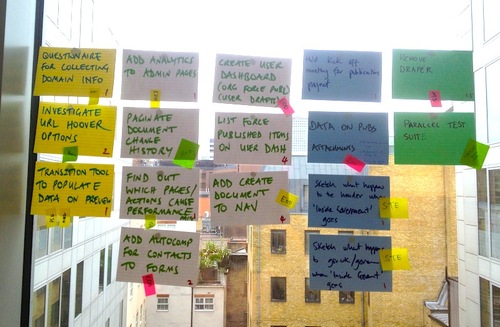
June
G-Cloud moved over to GDS, a large part of what would later become the Digital Marketplace.
3 June
Government announced savings of £10 billion as a result of "fundamental reform of operations". The following week, GDS blogged about its contribution of over £500 million, emphasising the importance of spend controls and the Technology Code of Practice.
7 June
Richard Sergeant announced the first service assessments, measuring new digital services against the criteria in the Service Standard.
13 June
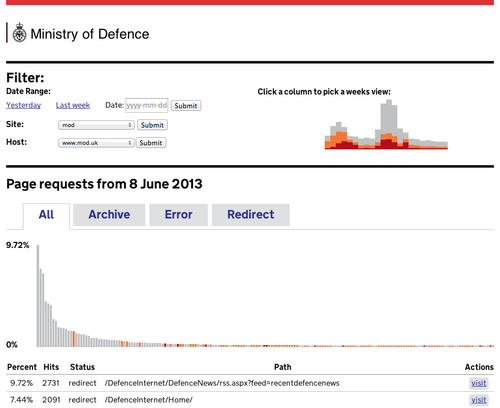
Neil Williams explained the transition tool.
18 June
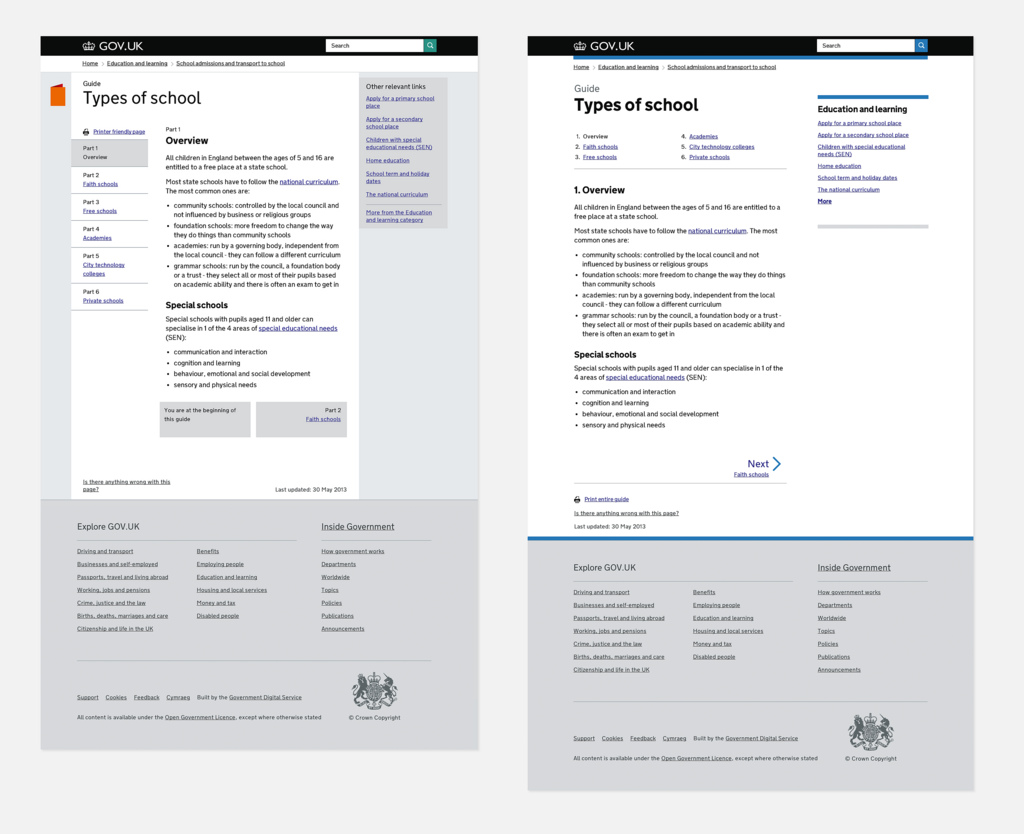
Designer Guy Moorhouse explained how a set of icons we'd been using on GOV.UK were removed, because:
We had no user data to work from when we first introduced the icons, so we based our decision on our judgement of what felt right. However, over time and after lots of user testing sessions it became apparent that they weren't achieving the intended result. Users would often click on the icons, thinking that they'd "do something".
This became a story that GDS referred to repeatedly in the months and years that followed, because it showed iterative design in action.
2 July
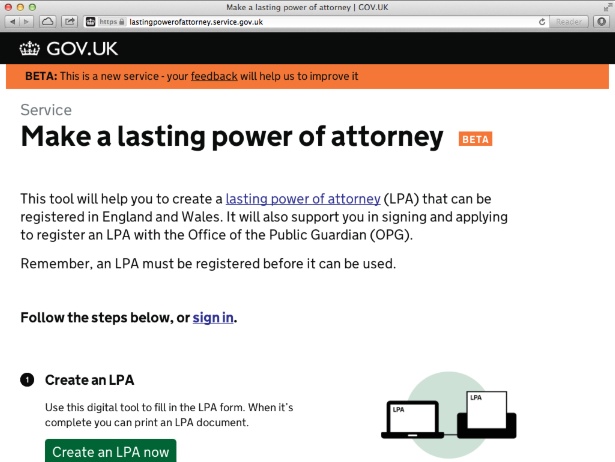
Lasting Power of Attorney, one of the exemplar projects, reached public beta.
2 July

Head of Content Design Sarah Richards wrote: "2 weeks ago, we won a Black Pencil." A D&AD Black Pencil is one of the most coveted awards in design. It recognises only the most outstanding work and just 1 or 2 are awarded each year. Some years, none are awarded at all.
9 July
The launch of the first Digital Services Framework, which would eventually become another part of the Digital Marketplace.
17 July

On the day of the Sprint Alpha event, Mike Bracken summed up progress on the Transformation Programme exemplar projects so far, and announced a new dashboard page at gov.uk/transformation, designed to publicly track progress on each exemplar project as it moved through the discovery-alpha-beta-live cycle.
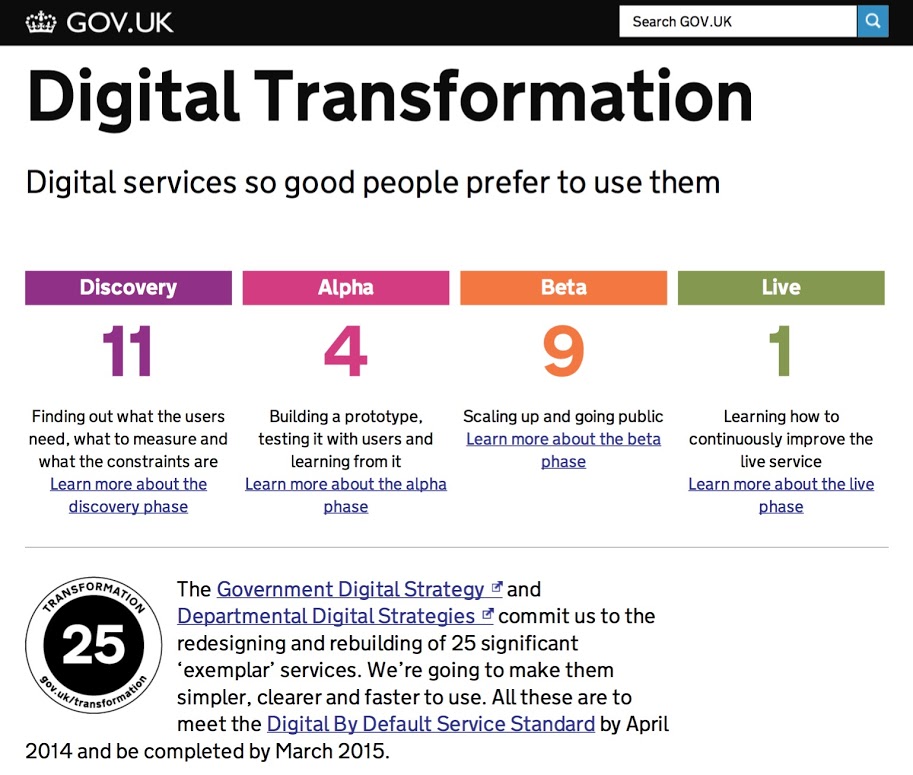
Mike Beaven followed up the next day, saying:
By 'transformation' we don't mean making websites. We mean everything: examining the whole business process involved in a transaction to make it consistent, high-quality and digital by default.
23 July
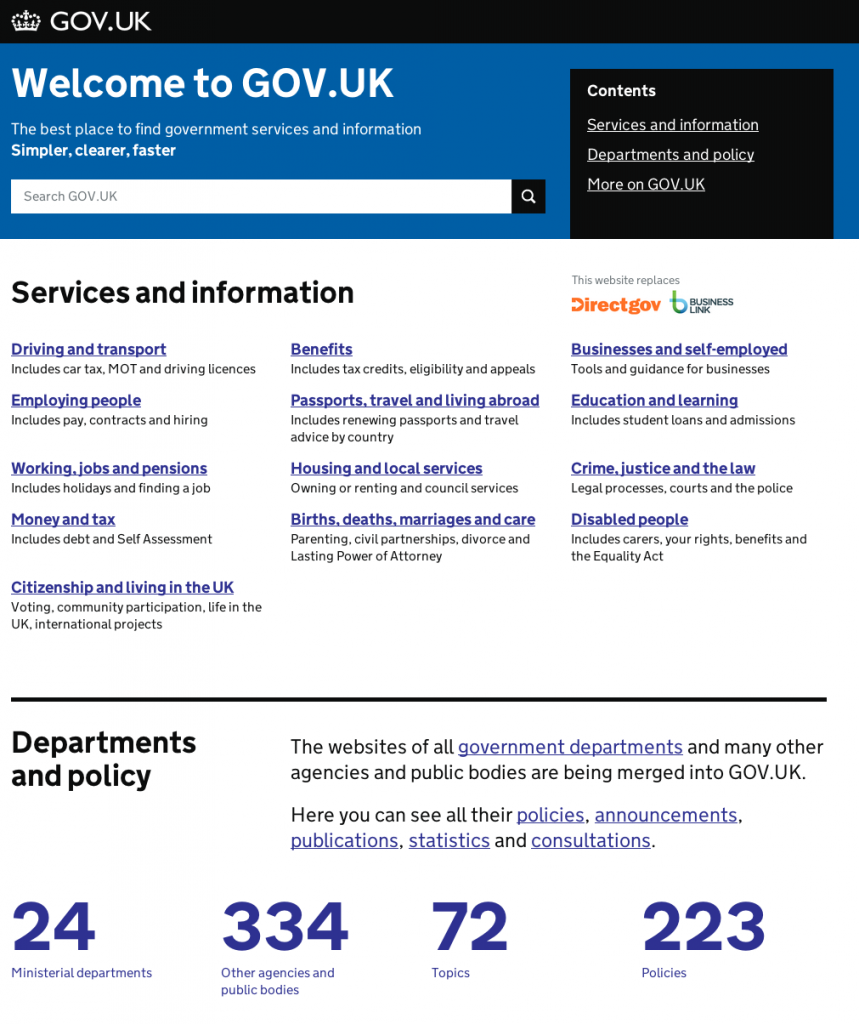
GOV.UK was updated with a slightly new look.
On the same day, teams from GDS and the Land Registry worked together to complete an alpha in a day.
25 July
Sarah Richards explained why we don't use FAQs: they're too slow and they lead to duplication.
26 July
The New Zealand government unveiled its new website beta, modelled on GDS design templates.
6 August
Tom Loosemore wrote about A/B testing, and how it helped boost applications to be on the NHS Organ Donor Register:
One small change to this one page on GOV.UK has lead to around 10,000 additional people joining the organ donor register each month. This one page is now the third biggest source of new registrations, behind doctors surgeries and the DVLA.
8 August
A blog post explaining how GOV.UK was designed so that pages about specific organisations and people never have to be deleted:
Historically, government websites didn't make life easy for historians. When departments or agencies closed, merged, split or got renamed through "machinery of government changes" (as these kinds of structural changes are lovingly known), in the past the affected organisations' websites tended to be unceremoniously shut down or overhauled ...With GOV.UK, however, we are building the site so that the rich, fascinating and downright useful data about these kinds of changes is easy to understand, preserved for posterity and (soon) available for re-use.
1 September
GDS made posters for the Design Principles.
4 September
Launch of the GOV.UK Blogs platform.
20 September
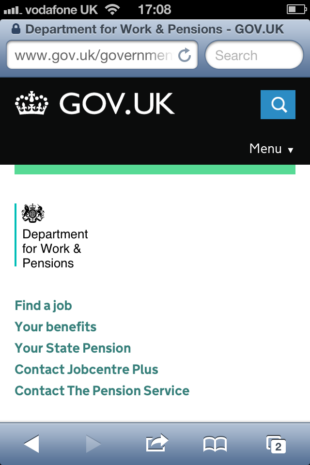
27 September
Liam Maxwell on open standards:
Selecting and implementing open standards will make our services better and give us more flexibility in choosing our suppliers. On Tuesday, the board recommended that we adopt four open standards to help solve two of our first user needs based challenges.
1 October
After months of preparation, the first of 300 agencies started moving their websites to GOV.UK, part of the project known internally as “transition”.
9 October
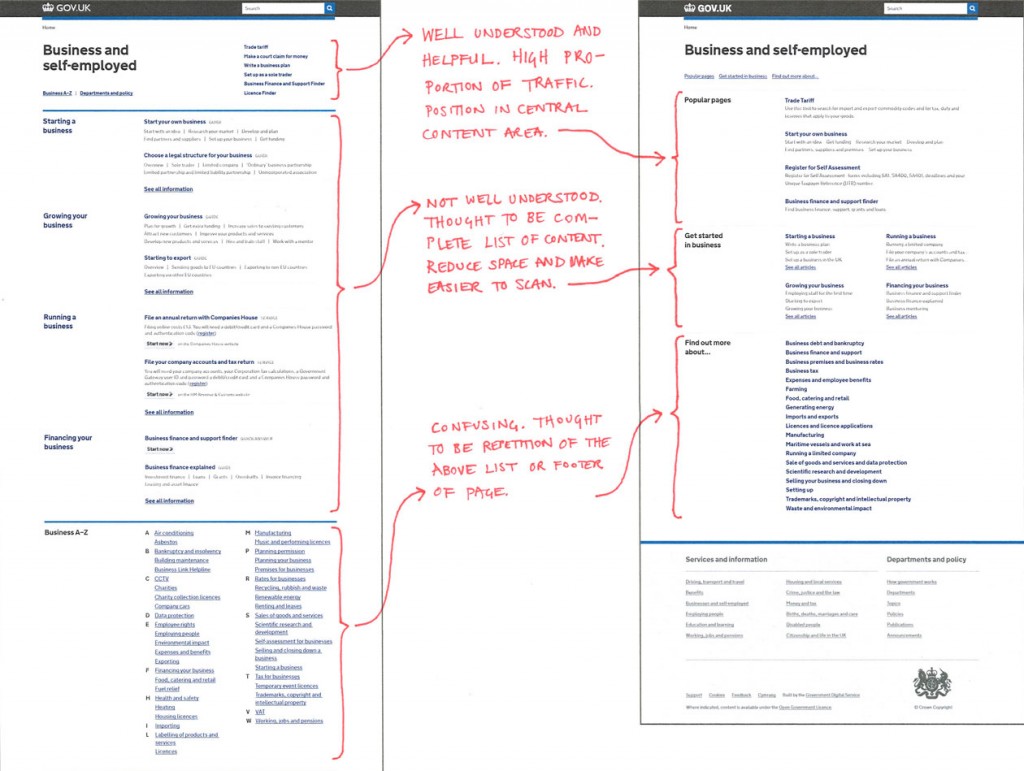
The GOV.UK team wrote about improving browse navigation.
14 October
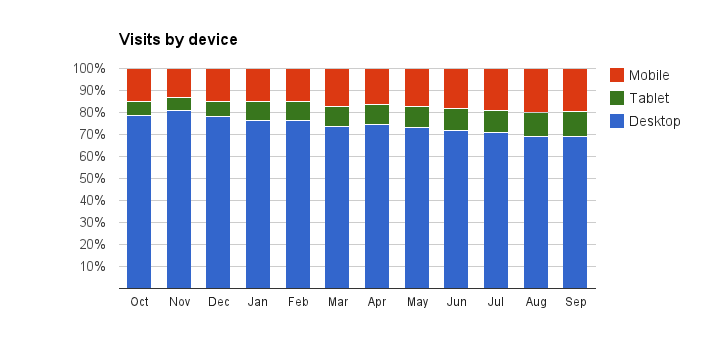
A year after GOV.UK went live, Tara Stockford looked at the data and noticed a rise in traffic from mobile devices.
https://www.instagram.com/p/fc8gecJ8fo/
17 October
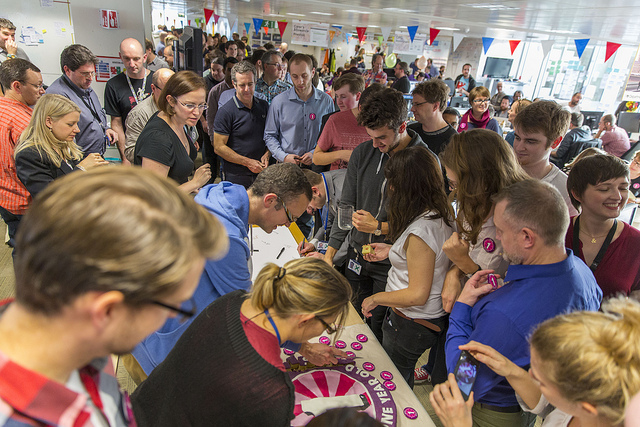
GOV.UK's 1st birthday. Martha Lane Fox came to visit, and there was cake. (More photos.)
Data Analyst Peter Jordan wrote up some of the data insights: “GOV.UK averages over 6 million unique visitors per week.”
Then-Head of GOV.UK James Thornett wrote a summary of progress over the first year.
Mike Bracken addressed the Code for America summit in Washington, DC.
18 October
G-Cloud reached the £50 million sales mark.
25 October
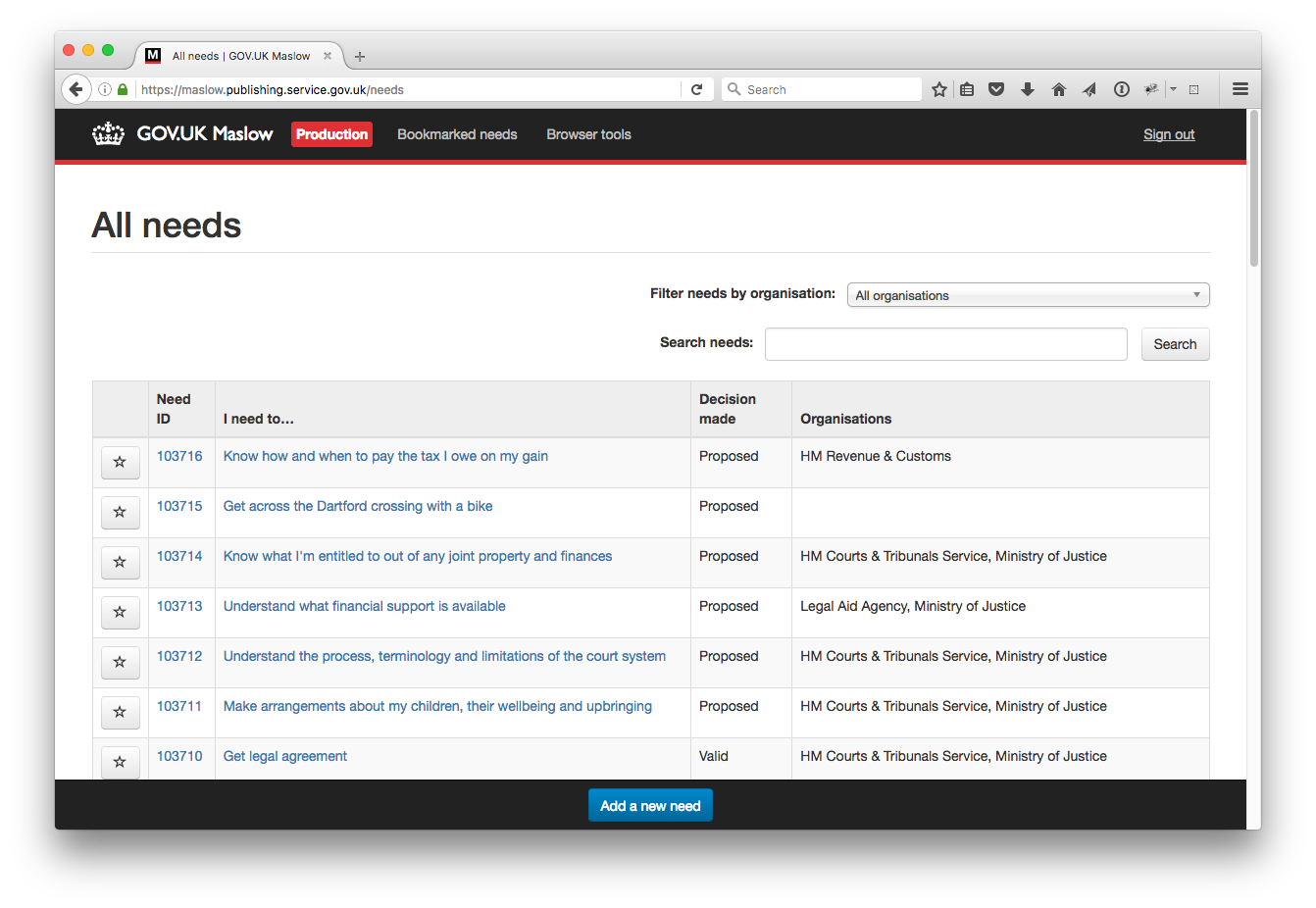
Lisa Scott wrote about a new internal tool called Maslow, designed to help them capture user needs and track performance of which site pages meet them.
29 October
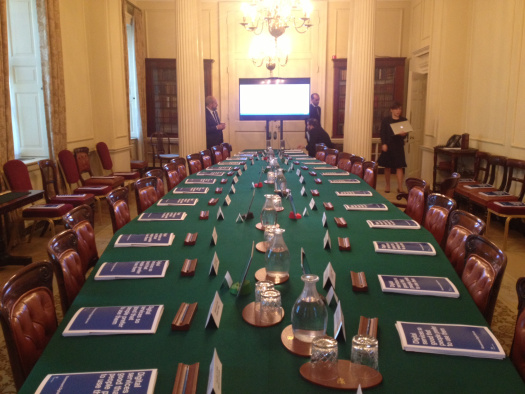
GDS attended Cabinet. We took big screens and iPads. We wanted to make sure all members of the Cabinet understood our work as clearly as possible.
Afterwards, Mike Bracken said:
Most encouraging for me though was hearing from ministers just how strongly the principles behind our work have resonated with them. The questions they asked all came from the perspective of ‘What does this mean for users? How does it meet their needs?’ Starting with the needs of users has led to a radical shift in the way we build and provision government services. That's a huge thing.
30 October
The Identity Assurance team released a beta of the hub, an essential component of the service that would later become GOV.UK Verify:
The hub will manage communications between users, identity providers and government service providers. It will allow users to select and register with an identity provider, and then use their assured identity to access digital services.
31 October
Pete Herlihy visited Estonia, another country whose government built up close ties with the team at GDS:
Possibly driven by the timing of their independence from the Soviet Union (1991), the Estonians saw technology as crucial to establishing and running the country. It was, and continues to be, an astute group of political and civic leaders with the vision and determination to make the most of the technological opportunities available.
1 November
Kathy Settle wrote an update on work done with departments to implement the Digital Strategy:
We’ve been concentrating on things like our HR and recruitment work, and developing frameworks to help buy in the right digital services and suppliers. We've also been changing the way we lead, coordinate and deliver technology to support digital. The Office of the Chief Technology Officer is now working with a Technology Leaders network drawn from experts across government to provide strategic direction and promote best practice on how technology can support digital.
6 November
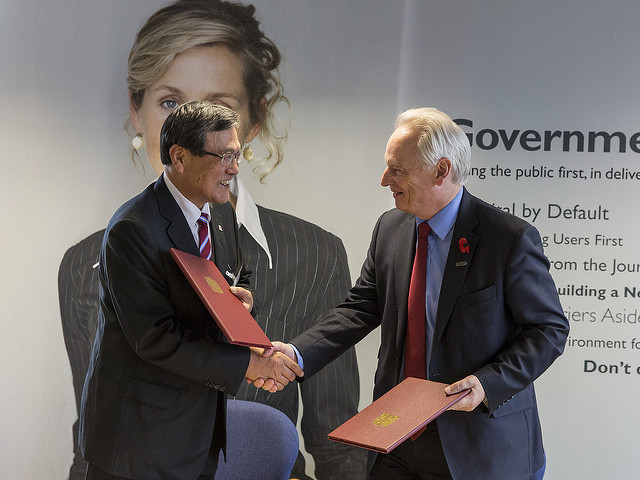
Choi Mun-kee, Korean Minister of Science, ICT and Future Planning visited GDS and met Francis Maude. Liam Maxwell wrote about his visit to South Korea.
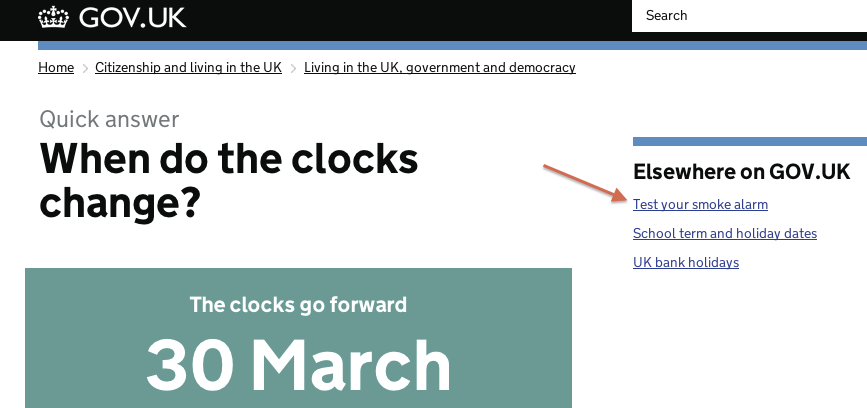
On the same day, the GOV.UK team experimented with a “Test your smoke alarm” link on the “When do the clocks change?” page. Paul Cronk wrote up their initial findings.
7 November
GDS hosted Sprint Share in Birmingham, a chance for people working on transformation exemplar projects across government to get together and share their experiences.
12 November
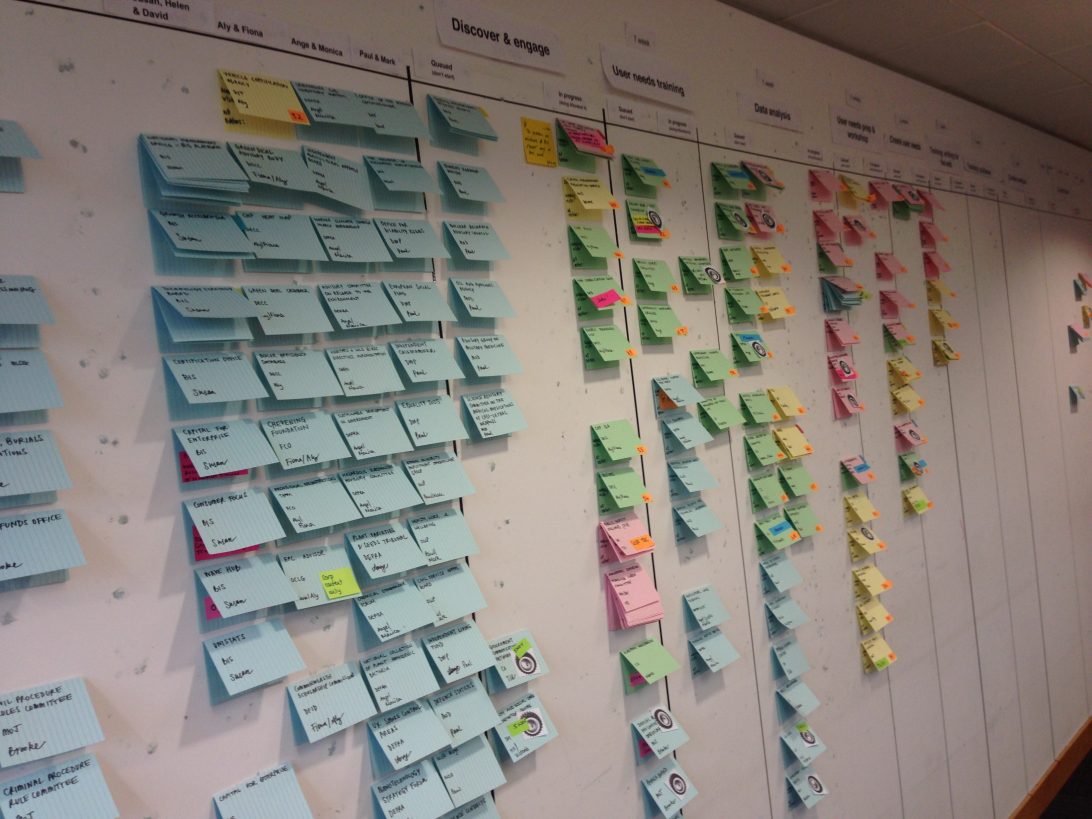
13 November
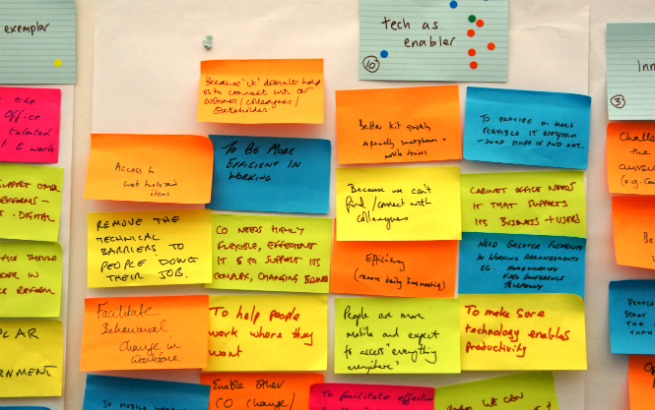
Start of the Cabinet Office Technology Transformation (COTT) project. Tom Read wrote:
Our aim is to deliver modern, flexible technology services that are at least as good as those people use at home. These services will also be cheaper than those currently in place.
14 November

Designer Guy Moorhouse explained the evolution of "start pages".
28 November
The Digital Services Store went live (later it became part of the Digital Marketplace).
29 November
Martha Lane Fox stepped down as Digital Champion:
If you’re a regular reader of this blog then you’ll know how often we refer to Martha’s report. It’s impossible to overstate its importance to GDS. It gave government the impetus to assemble this team, and it gave us a mission and a mandate to get on with making world-class, digital by default services.
12 December
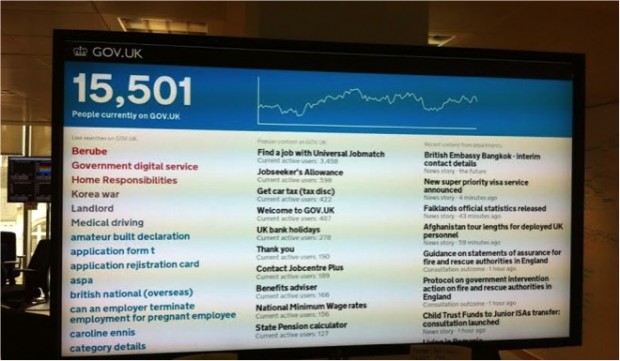
Analyst Ashraf Chohan explained the Performance team’s efforts to display data in real-time, including the real-time search screen they set up for the GOV.UK team.
20 December

Half a billion views on GOV.UK since it launched just over a year previously.

